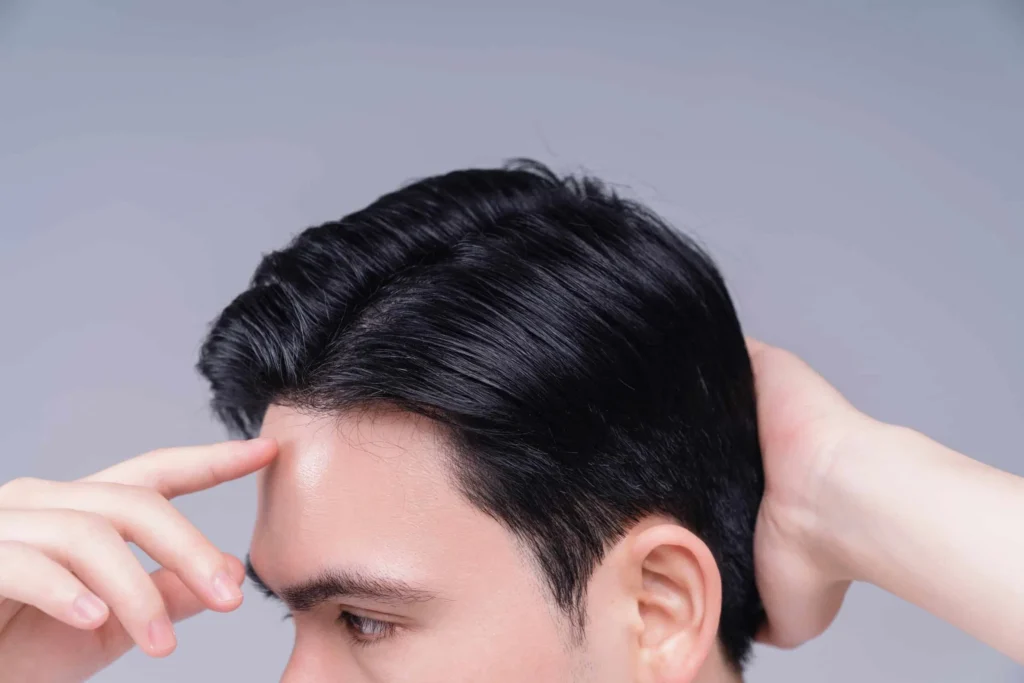Are the Results of a Hair Transplant Permanent?
Struggling with hair loss can be a distressing experience for many people. Men, in particular, may feel embarrassed by balding and thinning in areas of their hair. It is no wonder that many in Singapore have decided on hair transplant to solve their hair woes.
A hair transplant treatment promises natural-looking growth by filling in thinning and balding regions with your own hair follicles. When considering this hair loss treatment, you might ask whether the results are for good. In this article, we discuss the outcomes of a hair transplant and what factors impact how long results would last.

Key factors that influence your hair transplant outcome
A follicular unit extraction (FUE) hair transplant is a permanent transformation. This cosmetic procedure is performed by extracting hair follicles from a donor area on your body which are then transplanted onto balding areas of your scalp.
The transplanted hair follicles will embed in the scalp tissues, growing hair and eventually following the natural hair growth cycle. However, to maintain growth, a few factors need consideration.
Source of donor hair
The source of donor hair is a key factor in determining the success and permanence of an FUE hair transplant. Typically, the donor area where hair follicles are extracted from, are the back or sides of the scalp.
These areas are resistant to the hormone dihydrotestosterone (DHT), a key contributor to male pattern baldness. As a result, the transplanted hair maintains its resistance to DHT, making it less susceptible to falling out over time.
Technique used
The technique employed during the hair transplant procedure also significantly impacts the permanence of the results.
FUE is a primary method that extracts individual follicular units. This method is generally associated with minimal scarring and quicker recovery and can yield long-lasting results when performed by skilled surgeons.
Stability of the recipient area
The stability of the recipient area, where the hair is transplanted, is crucial. If the balding or thinning in this area is due to genetic factors, the transplanted hair is less likely to be affected by the natural progression of hair loss.
However, if the hair loss is caused by stress, medications, or other non-genetic issues, additional hair loss may occur over time.
Individual variability
Individual variability plays a role in the success of a hair transplant. Factors such as age, overall health, and the progression rate of natural hair loss can vary from person to person.
Younger individuals often experience more stable and long-lasting results, as their pattern of hair loss is not as advanced.
Post-transplant care
The care you provide to your transplanted hair after the procedure is crucial for ensuring long-term success.
While the procedure enables hair follicles to take root, how you care for your newly transplanted hair in the days, weeks, and months following the procedure significantly impacts the final outcome. Here are some reasons why.
Post-Transplant Treatment Care
Prevent infection
Proper care helps minimise the risk of infections that could impact the transplanted follicles.
Facilitate healing
Following post-transplant care instructions helps minimise scabbing, redness, and swelling, allowing the transplanted hair follicles to settle into their new environment.
Protect the transplanted follicles
Protecting the transplanted area from scratching, rubbing or injury promotes the survival and growth of the transplanted hair.
Minimise shock loss
Shock loss is a temporary shedding of existing hair in the recipient area, a natural response to the trauma of the transplant. Adequate care helps minimise shock loss and allows the transplanted hair to emerge without unnecessary hindrance.
Optimise blood circulation
Good blood circulation is crucial for the nourishment of hair follicles. It supports the growth of transplanted hair.
Promote long-term scalp health
Post-transplant care includes the use of specialised shampoos, medications, and other recommended practices to promote a healthy scalp environment conducive to ongoing hair growth.
Natural progression of hair loss
While a hair transplant can offer a permanent solution to hair loss in the treated areas, it’s essential to acknowledge that the natural progression of hair loss may continue in other parts of the scalp.
Some individuals undergo multiple sessions or combine hair transplants with other hair loss treatments to maintain the overall aesthetic appearance. Regular follow-ups with your surgeon can help monitor the progress and address any concerns that may arise.
Additionally, adopting a healthy lifestyle, managing stress, and avoiding factors contributing to hair loss can contribute to the longevity of your results.
Hair transplant in Singapore
A hair transplant is for good, with the transplanted hair retaining its genetic resistance to DHT. However, maintaining growth of the transplanted hair depends on the factors discussed earlier. By understanding these factors and making informed decisions about a hair transplant, you may achieve long-lasting and satisfactory results.
At the heart of any successful hair transplant procedure is the expertise of the surgeons performing it. Alaxis Medical & Aesthetic Surgery has a team of highly skilled surgeons in Singapore, with a proven track record in hair restoration. Our professionals are experienced in hair transplant techniques, ensuring that you receive personalised and effective treatment.
To learn more about FUE hair transplant and its cost, contact us now.



